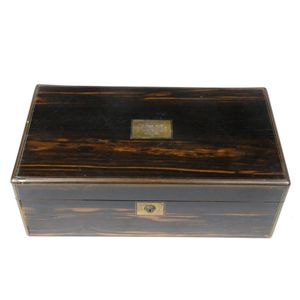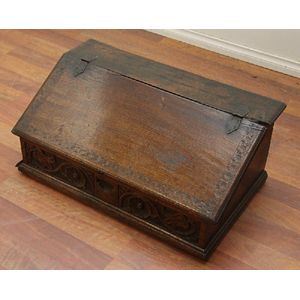Georgian Oak Bible Box with Fitted Interior
A Georgian carved oak bible box having hardware and fitted interior. 30 cm high, 75 cm wide, 42 cm deep
You must be a subscriber, and be logged in to view price and dealer details.
Subscribe Now to view actual auction price for this item
When you subscribe, you have the option of setting the currency in which to display prices to $Au, $US, $NZ or Stg.
This item has been sold, and the description, image and price are for reference purposes only.
- Oak - Native to Europe and England, oak has been used for joinery, furniture and building since the beginning of the medieval civilisation. It is a pale yellow in colour when freshly cut and darkens with age to a mid brown colour.
Oak as a furniture timber was superceded by walnut in the 17th century, and in the 18th century by mahogany,
Semi-fossilised bog oak is black in colour, and is found in peat bogs where the trees have fallen and been preserved from decay by the bog. It is used for jewellery and small carved trinkets.
Pollard oak is taken from an oak that has been regularly pollarded, that is the upper branches have been removed at the top of the trunk, result that new branches would appear, and over time the top would become ball-like. . When harvested and sawn, the timber displays a continuous surface of knotty circles. The timber was scarce and expensive and was used in more expensive pieces of furniture in the Regency and Victorian periods. - Bible Box - A lidded box, often made of oak or walnut with incised carving, designed to hold the family bible with its record of births, deaths and marriages. They were sometimes set on a stand and were popular in the 17th and 18th century, although there are also 19th century examples.
- Georgian - As an English stylistic period, Georgian is usually taken to cover the period from George I (1714) to the Regency of Prince George (1811-20), although the period from 1800 to 1830 is sometimes designated as the Regency period. During the Georgian period the great English cabinetmakers and designers such as Chippendale, Hepplewhite, Adam Sheraton etc., were all active.
Therefore there isn't a single 'Georgian style' as such and to say something is 'Georgian', usually means it was made between 1714 and 1830. This assumes we discount George V and George VI, both being from the 20th century.
The styles popular at the time of each reign were:
George I (1714-1727) saw out the last years of the Baroque period.
George II (1727-1760) reigned during the Rococo period.
George III (1760-1820) saw the last gasp of the Rococo, all of the early Neo-Classic 'Adam style' and most of the later neo-Classic 'Regency style'.
George IV (Prince Regent 1820-1830)encompassed the last of the 'Regency' style.
William IV's reign (1830-1837) was something of a no man's land (stylistically) and he wasn't a 'George' anyway. He covered the last glimmerings of 'Regency' and the start of the 'Victorian' style.
This item has been included into following indexes:
Visually similar items

Sold by
in
for
You can display prices in $Au, $US, $NZ or Stg.

Sterling silver engine turned card box, hallmarked Birmingham 1956. Weight 526gms
Sold by
in
for
You can display prices in $Au, $US, $NZ or Stg.

Britannic 9ct gold compact 7.6 cm x 5.2 cm, marked 9ct BRITANNIC, 128.5 grams
Sold by
in
for
You can display prices in $Au, $US, $NZ or Stg.

A Victorian Coromandel wood writing box, brass bound, the interior with tooled leather slope, secret drawers, compartments, etc., the lid with presentation plaque, requires some attention to interior. 50 cm x 27 cm x 18 cm
Sold by
in
for
You can display prices in $Au, $US, $NZ or Stg.
